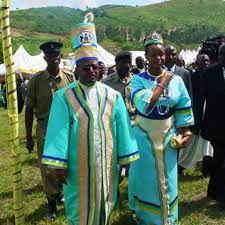
The independence of Rwenzururu kingdom by the Bakonzo and Baamba ethnic groups was
formally recognised on cultural institution; Obusinga Bwa Rwenzururu on 19th October 2009.
This was after its struggle for freedom from Tooro kingdom, oraginised by peasants in the
Rwenzururu movement. Originally, the Rwenzururu kingdom was founded in 1963, but was
disbanded in 1982. The first king was King Isaya Mukirane who declared himself King with the
support of tradtional elders after Tooro Kingdom reject the separates demands from the
Rwenzuru people on grounds of marginalization and mistreatment by the Tooro people.
Rwenzururu is a kingdom in western Uganda, located in the Rwenzori Mountains on the
border with the Democratic Republic of the Congo. The kingdom includes the districts of
Bundibugyo, Kasese and Ntoroko. Rwenzururu is also the name given to the region the
kingdom is located in.
The Rwenzuru people have a history of rebellion against both the Biritsih and Tooro kingdom,
for example in 1919, the British were faced with a first armed rebellion of the Bakonzo against
the Toro Kingdom. This struggle, also known as the ‘Abayora revolt’(Syahuka-Muhindo 2004),
was a reaction to the imposition of colonial rule on the Bakonzo, and more particularly to the
forced assimilation of Bakonzo into the Toro culture and the enforced use of the Rutoro
language; in addition to forced labour and taxation (Jorgensen 1981).
The people in the kingdom are called Banyarwenzururu, under the leadership institution of
Mumbere as Omusinga Irema-Ngoma I. After the death of King Isaya Mukirane in September
of the year 1966, he was succeeded by his teenage son, Charles Wesley Kisembo (Pasteur
1967: 2-3), who, because he was a minor when he became king, ruled with the help of a regent
until he attained majority age. King Charles Kisembo was renamed Omusinga Charles Wesley
Mumbere Irema- Ngoma of the ruling Obusinga Bwa Rwenzururu.





